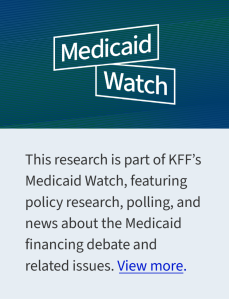On Medicaid Expansion, History Matters
 Some Republicans who want to reduce federal funding for Medicaid have characterized the Medicaid expansion as unjust because the federal government provides a 90% match to states for uninsured adults they characterize as “able bodied,” while it provides a smaller match for younger, older and disabled beneficiaries they characterize as Medicaid’s traditional and more needy populations. The 90% match takes money from the “traditional” populations, they say. Republicans have talked about reducing the federal match for the expansion population, recently leaning towards gradually imposing a per capita cap on it or dropping the idea altogether.
Some Republicans who want to reduce federal funding for Medicaid have characterized the Medicaid expansion as unjust because the federal government provides a 90% match to states for uninsured adults they characterize as “able bodied,” while it provides a smaller match for younger, older and disabled beneficiaries they characterize as Medicaid’s traditional and more needy populations. The 90% match takes money from the “traditional” populations, they say. Republicans have talked about reducing the federal match for the expansion population, recently leaning towards gradually imposing a per capita cap on it or dropping the idea altogether.
Many of these “able bodied” adults are in ill health and the majority of adult enrollees are working. More importantly, states that have expanded Medicaid spend more per capita on their “traditional” populations than states that do not.
 But the larger problem with the argument that the 90% match is inequitable and harmful isn’t factual, it’s history. The expansion was enacted by Democrats as part of the ACA. Its purpose, along with the ACA Marketplaces, was not to reform Medicaid, but instead to address the growing problem of the uninsured in America, which was then regarded as health care’s biggest problem after decades of trying to expand coverage had produced no progress. As the chart shows, the number of people without any health coverage reported by the Census peaked at 46.5 million in 2010, right around the time the ACA passed. Many Democrats wanted to go further at the time and favored a Medicare for All style plan. Others wanted more generous ACA coverage provisions than those ultimately included in the law. Republicans widely opposed the law and the coverage expansions and favored other approaches to covering the uninsured or didn’t see the problem as urgent. It was a legitimate debate about the role of government and federal spending and about how to cover the uninsured, and passage was a near thing, as were subsequent repeal debates. It was not a debate about Medicaid or whether and how to expand it.
But the larger problem with the argument that the 90% match is inequitable and harmful isn’t factual, it’s history. The expansion was enacted by Democrats as part of the ACA. Its purpose, along with the ACA Marketplaces, was not to reform Medicaid, but instead to address the growing problem of the uninsured in America, which was then regarded as health care’s biggest problem after decades of trying to expand coverage had produced no progress. As the chart shows, the number of people without any health coverage reported by the Census peaked at 46.5 million in 2010, right around the time the ACA passed. Many Democrats wanted to go further at the time and favored a Medicare for All style plan. Others wanted more generous ACA coverage provisions than those ultimately included in the law. Republicans widely opposed the law and the coverage expansions and favored other approaches to covering the uninsured or didn’t see the problem as urgent. It was a legitimate debate about the role of government and federal spending and about how to cover the uninsured, and passage was a near thing, as were subsequent repeal debates. It was not a debate about Medicaid or whether and how to expand it.
The linked coverage expansions also came after decades of states not being able to and/or not wanting to expand coverage for the uninsured. That led Democrats, some grudgingly, to expand coverage by building on the existing Medicaid program and establishing the ACA Marketplaces with subsidized coverage, reducing the number of uninsured to just over 25 million by 2023. Ninety-two percent of the population is now covered by some form of health insurance, although many more Americans, including tens of millions with coverage, struggle with their medical bills.
Prior to the ACA, states could cover parents but could not cover adults without dependent children in Medicaid. While originally structured as a requirement to expand Medicaid with full federal support that phased down to the current level of 90%, the Supreme Court effectively made the expansion voluntary. New authority in the ACA to cover adults without dependent children, enhanced federal match, and lots of advocacy and politics eventually led 40 states and DC to take up the expansion.
Republicans who would cut funding for the expansion almost certainly remember that for decades, states—and likely their state—did not or could not cover uninsured adults before passage of the ACA with its Medicaid expansion and federally subsidized marketplaces. That was the reason the expansion was mandated (before the Supreme Court made it voluntary) with a 90% federal match to make it palatable and feasible for states to expand their Medicaid programs under the law. After the Court’s decision, the 90% match became an incentive, in effect a lure, to make it in the state’s interest to cover more of their uninsured. Even then, 10 states, including famously Texas and Florida, have not done so.
Underneath the recent claims that the 90% match for the expansion population is harmful are the same divisions that have always plagued the debate about covering the uninsured. Many, but by no means all, Republicans oppose government subsidized insurance to cover people without health insurance, think the problem is exaggerated, favor other ways to address it (at least partially), and want to reduce federal health spending, not increase it. Virtually all Democrats support expanding coverage, and with 25 million Americans still without health insurance, would continue to expand federally funded health coverage if they could.
Finally, there’s one indicator that the issue is broader than Medicaid: Republicans have also been balking at extending the enhanced ACA tax credits, which benefit about 24 million people, including many in red states. If they do agree to a compromise on the tax credits later this year, it will be in no small part to avoid taking heat in the midterms.
